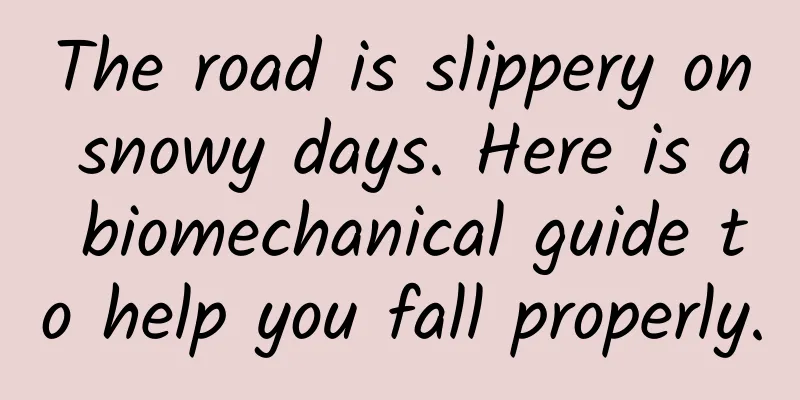The road is slippery on snowy days. Here is a biomechanical guide to help you fall properly.

|
Heavy snow has fallen across the northern part of the country in recent days, creating beautiful scenery (Figure 1). Figure 1: Fun on a snowy day However, snowy days also have annoying problems. The roads are slippery and people can easily fall. The mildest fall is unbearable pain, while the worst fall may result in fractures. Arm fractures are the most common, followed by leg and hip fractures. Therefore, we often hear "experts" say that the correct posture for falling on slippery roads in snowy weather is to use your elbows as little as possible to land on the ground, and instead land on the buttocks, middle of the legs, shoulders, back and other thick fleshy areas, and to protect your head with your arms and roll over. Today, I will talk about the "correct posture for falling on slippery snowy roads" from a biomechanical perspective, and whether it is just as the "experts" say. First, when a person is about to fall, they are not prepared. Subconsciously, they will first use their hands and feet to support their bodies (Figure 2). Therefore, they cannot control the posture of their body or choose where to land. Figure 2: The road is slippery in snowy weather and it is easy to fall Secondly, not to mention whether a person has enough time to prepare for a fall, even if he can find the correct "pose" for falling, the consequences may be very different from what the "experts" expected! The human body is a multi-component, multi-joint motion system consisting of the trunk, head, and limbs. The musculoskeletal system of the limbs (abbreviated as the musculoskeletal system) forms an important segmental motion unit and can resist external forces and absorb vibrations like springs connected in series. Therefore, whether it is daily running and jumping, or landing in extreme sports (such as skiing and parachuting), people try to let their limbs land first (Figure 3), so as to use the musculoskeletal system of the limbs to absorb vibrations and avoid impact and damage to the trunk and head. Figure 3 Landing movements in extreme sports (such as skiing and skydiving) This shows that since human evolution, the natural falling posture is to land on all fours, with the purpose of protecting important core organs. Think about it, if you fall on a slippery road in the snow, is it more dangerous to break your arm or your shoulder, hip or skull? Let's understand it from the perspective of bionics. We have all heard of the stories of animals such as geckos and lizards "cutting off their tails to survive". Why can "cutting off the tail" "survive"? Of course, the end tissues of the body are not fatal. "Reluctantly" giving up the "scraps" at the end of the body can better protect the important organs in the core. This is the optimal result of the survival of the fittest and continuous evolution of species in the cruel natural environment. Humans have also evolved in this way, so it is not difficult to understand similar principles. So, from the perspective of "medical biomechanics", if you fall on a slippery road in the snow, the natural way to fall is to land on all fours. Arms are important, but not as important as the core organs. Landing on the ground with arms can also use the musculoskeletal system of the limbs to buffer and absorb vibration, reducing the impact damage to the core organs. Dear readers, do you think that the way the “experts” tell you will cause you to fall harder, or the way “medical biomechanics” tells you will cause you to fall harder? |
<<: Home care for children with acute respiratory infections, please avoid these "pitfalls"
>>: Nutritional comparison of 22 kinds of nuts, you will never guess the first one!
Recommend
Effects and functions of Wuhua fruit leaves
In life, many people grow some figs at home as po...
Cordyceps sinensis cannot be drunk directly in water
Many people should be very familiar with the medi...
Can cancer spread among family members? Eating vegetarian food every day will prevent high blood lipids? Here is the list of scientific rumors for May
1. Should the thyroid gland be removed if a thyro...
What are the medicines for nourishing qi and blood?
Some people are always weak, but they cannot find...
The chicle tree is in bloom, and the smell is intoxicating!
There is a kind of green tree on the streets of H...
Many areas have seen adult paralysis "soft disease", which was eventually confirmed to be related to this
I have obviously gotten enough sleep and eaten en...
The Asian Cup has begun! Small footballs have made fans crazy, how can we watch the game rationally?
The much-anticipated Asian Cup has begun, and it ...
Seasonal changes on the tip of your tongue: Can you eat out-of-season fruits?
For a long time, people have had a subtle attitud...
4,200 years ago, Chinese ancestors were already driving cars?
The Pingliangtai Site in Huaiyang was selected as...
Red alert! Typhoon Trami's remnant vortex triggers heavy rains. How to avoid risks scientifically?
This year's 20th typhoon "Trami" ma...
Are you only focusing on meat, eggs and milk to supplement protein? You are also missing this "treasure" protein
Speaking of protein Many people's first react...
Protecting Northeast China's black soil and safeguarding China's "rice bowl"
Produced by | Science Popularization China Author...
A 5.2-magnitude earthquake occurred in Baoshan, Yunnan! Transfer! An effective guide to escaping and self-rescue in the event of an earthquake
A 5.2-magnitude earthquake occurred in Longyang, ...
State Post Bureau: The average monthly domestic express delivery volume will reach 14 billion pieces in 2024, and the rural market will become a new growth pole
Recently, according to media reports, China's...
The efficacy and function of Ciwu
Nowadays, our living standards are constantly imp...









